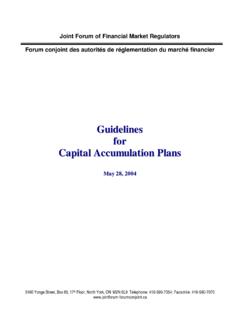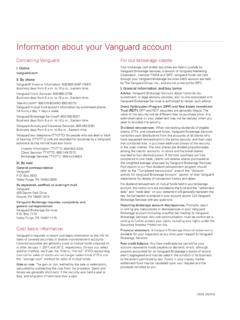Transcription of FINANCIAL PRODUCT DEVELOPMENT STANDARDS AND …
1 1 FINANCIAL PRODUCT DEVELOPMENT STANDARDS AND PRACTICES Report prepared by: Joint Forum PRODUCT Disclosure and Regulation Committee April 2, 2013 Joint Forum of FINANCIAL Market Regulators Forum conjoint des autorit s de r glementation du march financier 2 EXECUTIVE SUMMARY There are many factors driving the introduction of new products in the marketplace. These include FINANCIAL innovation, increased cross-sectoral competition amongst both PRODUCT manufacturers and intermediaries, and the changing needs of consumers as Canadians live longer. The range of FINANCIAL products and services that consumers can choose from is increasing. Some new products are complex in nature with risks not easily understood by consumers themselves or the intermediaries that advise them.
2 The need for consumers to purchase suitable products with a full understanding of the features of these products and associated risks is of critical importance. PRODUCT manufacturers, intermediaries, and investors themselves all bear responsibility in meeting this objective. The Joint Forum established a PRODUCT Disclosure and Regulation Committee to undertake an initiative to examine the responsibilities of FINANCIAL PRODUCT manufacturers, intermediaries and consumers in ensuring that Canadian consumers are offered suitable products and are able to make informed decisions, particularly in this uncertain FINANCIAL environment. The initial focus of the work of the Committee was on PRODUCT manufacturers and their risk assessment and PRODUCT disclosure practices at they relate to consumers.
3 In 2010, as a first step, a research paper was prepared on the issues described in the objective, examining both international and Canadian practices. A draft survey questionnaire for PRODUCT manufacturers was circulated to industry associations for feedback. Based on the feedback, a roundtable discussion was held with Advocis, CBA, CLHIA, IFIC and IIAC and representatives from their member organizations in September 2011. It was agreed that the next step would be to redesign a fact-finding survey that would be focused on the processes and controls around PRODUCT DEVELOPMENT as they relate to impact on consumers, with the involvement of the industry associations. A Joint Regulator/Industry PRODUCT Manufacturer Working Group was established and started meeting in November 2011.
4 The Working Group acknowledged that there is currently a greater degree of uncertainty in FINANCIAL markets, together with increasing consumer expectations and increasing complexity of products. Firms are managing in this environment with various risk assessment practices, while regulators continue to need to understand how firms are responding to these challenges. Both regulators and firms have a common interest in ensuring a competitive market where consumers' needs are met. Consequently, there is a desire for regulators to have an understanding of the practices and processes involved in manufacturing a PRODUCT , as it relates to consumers. The advice from the industry representatives on the Working Group was that a survey was not the most suitable first step in obtaining information from manufacturers.
5 They felt that, in the absence of a greater level of understanding, a survey would be constructed too broadly resulting in inconsistent interpretations and responses from participants. 3 To that end, the CLHIA and IFIC each submitted detailed written reports that described the PRODUCT DEVELOPMENT practices used by the life insurance industry and the mutual funds industry to manage risk in IVICs and mutual funds, respectively. The Committee has now completed its work and prepared the following materials which are included in this report: 1. Research Paper The paper reflects the current requirements, STANDARDS and practices for PRODUCT manufacturers in the United Kingdom, United States and Canada, as summarized below: United Kingdom - A principles-based regulatory scheme whereby the regulator has the ability to impose penalties on those that fail to meet regulatory requirements, while providing firms with the autonomy to decide how to meet such requirements.
6 United States - A mix of mandatory regulatory requirements and suggested best practices . Canada - An overview of the practices and processes presented in the CLHIA and IFIC reports. 2. Summary of Findings The document is a summary of the findings on international practices and STANDARDS in the research paper and the practices and processes detailed in the CLHIA and IFIC reports. These reports describe PRODUCT DEVELOPMENT practices used by the life insurance industry and the mutual funds industry to manage risk in IVICs and mutual funds, respectively. In preparing this material, the CLHIA and IFIC conducted a broad consultation with their member companies. About 25 companies were given an opportunity to provide input.
7 This document reflects input received from the CLHIA and IFIC. 3. PRODUCT List Mutual funds and segregated funds are the most mature FINANCIAL products with established risk practices and processes. A comprehensive list of other FINANCIAL products for which risk practices and processes could be examined was prepared and circulated to the Working Group for comment. Upon completion of the review, the Working Group has recommended that rather than creating a new list, the list of FINANCIAL products most commonly held by Canadian households for the purpose of accumulating wealth, as derived from the Investor Economics Household Balance Sheet Report, could be used. 4 Table of Contents 1.
8 PRODUCT MANUFACTURERS REGULATORY REQUIREMENTS AND GOVERNANCE STANDARDS FOR CONSUMER PRODUCTS (RESEARCH PAPER).. 5 2. SUMMARY OF FINDINGS - FINANCIAL PRODUCT MANUFACTURERS RISK ASSESSMENT AND PRODUCT DISCLOSURE PRACTICES .. 29 3. LIST OF PRODUCTS .. 33 ATTACHMENTS: CLHIA Report IFIC Report 5 PRODUCT MANUFACTURERS REGULATORY REQUIREMENTS AND GOVERNANCE STANDARDS FOR CONSUMER PRODUCTS (RESEARCH PAPER) Global Practices A 2008 report by the international Joint Forum (Basel Committee on Banking Supervision, International Organization of Securities Commissions, and International Association of Insurance Supervisors) surveyed both regulator and firms regarding customer suitability1. While the report does not cover specifically regulatory requirements / firm governance STANDARDS for PRODUCT manufacturers on identification and disclosure of risks to consumers, it sheds light on the extent suitability is examined by manufacturers in PRODUCT design.
9 Regulatory practices The international Joint Forum report reflects the results of a survey of bank, securities and insurance regulators in eleven countries. PRODUCT Design In PRODUCT design, the report notes, in general, countries do not have regulations that impose requirements on the PRODUCT design process, particularly retail products. With few exceptions, there are generally no restrictions on the design of new products. The exceptions noted in the report are: The US FINANCIAL Industry Regulatory Authority (FINRA)2 has issued guidance on PRODUCT design for structured products. The UK FINANCIAL Services Authority (FSA) expects firms to ensure products are soundly designed, even where manufacturers distribute solely or mainly through intermediaries.
10 The Joint Forum report notes this expectation is derived from an outcome under the FSA s Treating Customers Fairly Initiative, 3 which states that products sold in the retail market should be designed to meet the needs of identified consumer groups and targeted accordingly. 1 The Joint Forum, Customer suitability in the retail sale of FINANCIAL products and services. April 2009. Available at The report was prepared by a working group that included AMF participation. 2 The FINANCIAL Industry Regulatory Authority (FINRA), is the largest independent regulator for all securities firms doing business in the United States. 3 Under this initiative, although the FSA does not regulate the design of FINANCIAL products, it does expect firms to treat their customers fairly when considering the design of those products.




![B2B BANK FINANCIAL SERVICES INC. [NAME]](/cache/preview/e/9/4/5/0/d/f/4/thumb-e9450df4745bbeaca56c0ce98e3b2aaa.jpg)